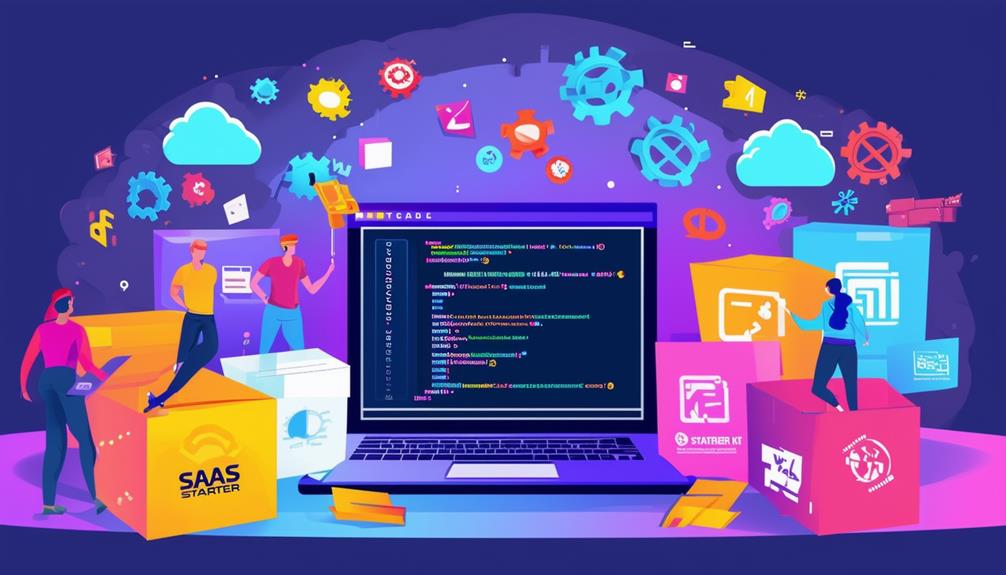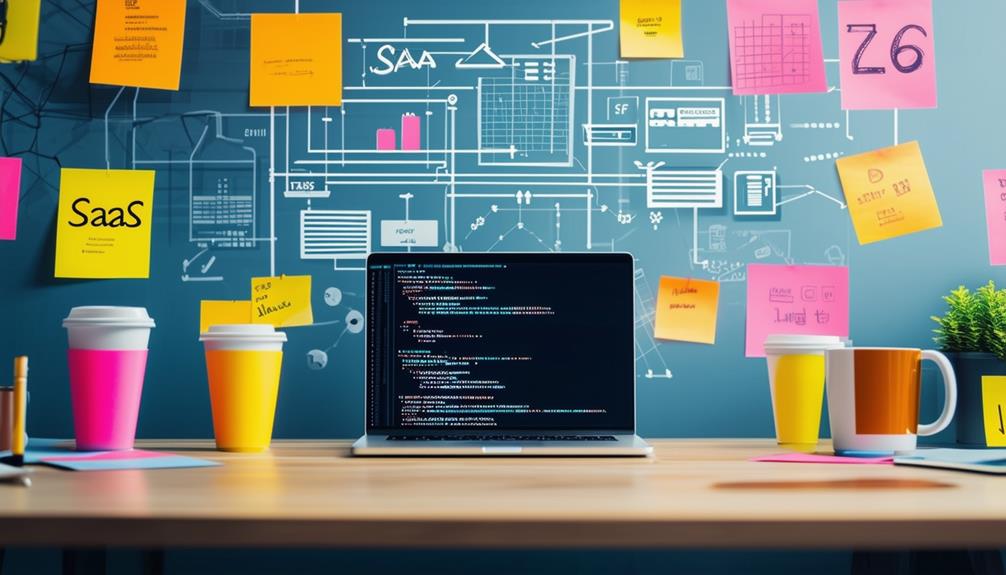When you’re building a SaaS boilerplate, integrating popular technologies can greatly enhance your product’s functionality and appeal. You’ll want to focus on essential components like robust authentication systems, scalable databases, and efficient API frameworks. Cloud services integration is vital for optimizing performance and reducing overhead costs. However, the real challenge lies in seamlessly incorporating these technologies while maintaining a streamlined, user-friendly experience. As you navigate this process, you’ll need to take into account not only the technical aspects but also security protocols, compliance requirements, and the potential for AI and machine learning implementation. The key to success is striking the right balance between cutting-edge features and practical usability.
Identifying Essential SaaS Technologies
A SaaS boilerplate’s success hinges on identifying and integrating the right technologies that’ll streamline development, enhance scalability, and boost user experience.
To build a robust foundation, you’ll need to focus on key areas: authentication, database management, API development, and front-end frameworks.
For authentication, consider OAuth 2.0 or JSON Web Tokens (JWT) to guarantee secure user access.
In database management, opt for scalable solutions like PostgreSQL or MongoDB, depending on your data structure needs.
For API development, RESTful or GraphQL architectures are essential, with frameworks like Express.js or Django simplifying implementation.
On the front-end, React, Vue.js, or Angular offer powerful tools for creating responsive interfaces.
Don’t overlook DevOps technologies; Docker for containerization and Kubernetes for orchestration can greatly improve deployment and scaling processes.
Cloud platforms like AWS, Google Cloud, or Azure provide extensive infrastructures for hosting and scaling your SaaS.
Implement analytics tools such as Google Analytics or Mixpanel to track user behavior and make data-driven decisions.
Cloud Services Integration
Building on the foundation of essential SaaS technologies, you’ll find that integrating cloud services into your boilerplate can greatly enhance scalability, reliability, and feature richness.
To begin, focus on incorporating cloud storage solutions like Amazon S3 or Google Cloud Storage. These services offer robust data management capabilities and seamless scalability.
Next, integrate cloud databases such as Amazon RDS or Google Cloud SQL. These managed database services reduce administrative overhead and provide automatic backups and scaling.
For serverless computing, consider AWS Lambda or Google Cloud Functions, which allow you to run code without managing servers.
Implement cloud-based authentication services like Auth0 or AWS Cognito to enhance security and simplify user management. For messaging and real-time communication, integrate services like Amazon SQS or Google Cloud Pub/Sub.
Don’t forget about monitoring and logging. Services like AWS CloudWatch or Google Cloud Monitoring provide invaluable insights into your application’s performance and health.
When integrating these cloud services, use well-documented SDKs and follow best practices for security and performance. Regularly update your dependencies and stay informed about new features and improvements in your chosen cloud platforms to maximize the benefits of cloud integration in your SaaS boilerplate.
AI and Machine Learning Implementation
To elevate your SaaS boilerplate’s capabilities, you’ll want to incorporate AI and machine learning functionalities, leveraging powerful tools like TensorFlow or PyTorch for advanced data analysis and predictive modeling.
Start by integrating these libraries into your stack and setting up a dedicated ML pipeline. This will enable you to process large datasets, train models, and deploy them within your application.
Implement natural language processing (NLP) features using libraries like spaCy or NLTK to enhance user interactions and automate text-based tasks. For image recognition and computer vision capabilities, consider OpenCV or Google’s Cloud Vision API. These tools can greatly improve user experience and automate complex processes.
To optimize your SaaS performance, incorporate recommendation systems using collaborative filtering or content-based algorithms. This will personalize user experiences and drive engagement.
Additionally, implement anomaly detection algorithms to identify unusual patterns in your data, enhancing security and fraud prevention.
Don’t forget to set up A/B testing frameworks to continuously improve your ML models. Use tools like MLflow for experiment tracking and model versioning.
Security Protocols and Compliance
In light of increasing cyber threats, you’ll need to implement robust security protocols and guarantee compliance with industry standards to safeguard your SaaS boilerplate and protect sensitive user data.
Start by integrating industry-standard encryption protocols like SSL/TLS for data in transit and AES-256 for data at rest. Implement multi-factor authentication (MFA) to add an extra layer of security to user accounts.
Ensure your boilerplate adheres to relevant compliance standards such as GDPR, HIPAA, or PCI DSS, depending on your industry. Regularly conduct security audits and penetration testing to identify vulnerabilities.
Implement a robust access control system using the principle of least privilege to limit user permissions.
Set up automated security monitoring tools to detect and alert you of potential breaches in real-time. Develop a thorough incident response plan to mitigate damages in case of a security breach.
Don’t forget to implement secure coding practices and regularly update all dependencies to patch known vulnerabilities.
Responsive Design and User Experience
Responsive design and user experience are critical components you can’t afford to overlook when integrating technologies into your SaaS boilerplate. To guarantee your application performs well across devices, implement a mobile-first approach using frameworks like Bootstrap or Tailwind CSS. These tools provide pre-built responsive components that adapt to various screen sizes, saving you development time and guaranteeing consistency.
Focus on optimizing page load times, as 53% of mobile users abandon sites that take over 3 seconds to load. Leverage lazy loading for images and implement efficient caching strategies to improve performance. Incorporate progressive enhancement techniques to guarantee core functionality works on all devices, then add advanced features for more capable browsers.
Prioritize accessibility by following WCAG guidelines, which can increase your potential user base by up to 20%. Use semantic HTML elements, provide alternative text for images, and guarantee proper color contrast ratios. Implement intuitive navigation patterns and clear call-to-action buttons to guide users through your application.
Regularly conduct user testing and gather feedback to identify pain points and areas for improvement. By prioritizing responsive design and user experience, you’ll create a more engaging and successful SaaS product.
To Wrap Up
You’ve now got the tools to integrate popular technologies into your SaaS boilerplate.
Remember to focus on essential components, leverage cloud services, and implement AI and ML where appropriate.
Don’t forget to prioritize security and compliance, and guarantee a responsive design for peak user experience.
By following these steps, you’ll create a robust, scalable, and competitive SaaS product.
Stay updated on emerging technologies to keep your boilerplate cutting-edge and market-ready.






